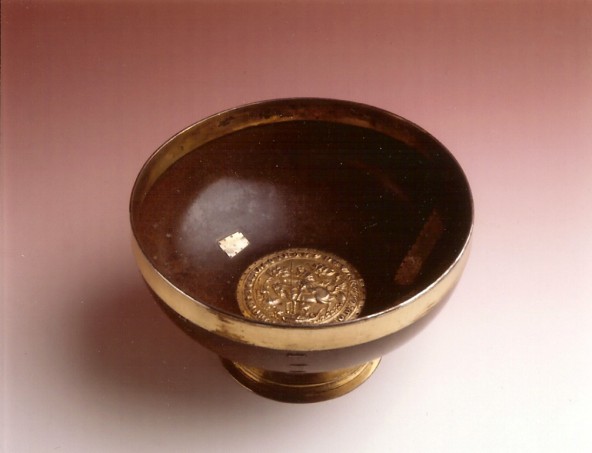The end of a year is often a good time to stand back and reflect on the past, something the historian does professionally a great deal of the time, but far less often personally. The end of 2014 may be a particularly pertinent time to do this, however, with the release at the end of last week of the results of the government-organised Research Excellence Framework (REF2014). These results, apart from giving British university departments an idea of how they are viewed against each other in terms of their research output and other measures such as ‘impact’ – engagement with those outside the university sector, will have implications for future research funding at higher education establishments.
Photograph: copyright Canterbury City Museums
The Guy of Warwick mazer: an often over-looked gem at Canterbury City’s Stour Street museum that belongs to St Nicholas’ Hospital, Harbledown. Mazers: generally maple wood, decorated, communal drinking bowls; this one is early 14th century with a stylised representation of the internationally famous Guy of Warwick romance. Guy, super-hero as giant and dragon slayer, was the honoured ‘ancestor’ of the late medieval great aristocratic Beauchamp family, the Earles of Warwick.
The ranking of published items by university staff members in terms of the book/article’s international or national worth/standing has much to recommend it. Yet, it is probably worth remembering that ‘local’ does not equal parochial and the size of a place is not everything. Thus as Professor Christopher Dyer ‘one of our most distinguished medievalists’ has said, small places mattered because without them the great places could not have functioned as they did. Consequently for a Research Centre such as this that champions local/regional (county) history, how those involved approach their chosen topic and the contextual implications their study illuminates regarding its immediate subjects and wider contemporary society is a hallmark of both the importance and vitality of such scholarship. Moreover, while publication in inter/national journals may now be seen as the ‘best’ (only) outlet, the county journal, including the Kent Archaeological Society’s Archaeologia Cantiana, remains a valuable place because not only does its individual membership extend well beyond the county boundary, but its institutional membership expands this readership into some of the country’s high-ranking academic institutions, as, of course, does the programme of putting digitised copies of articles from earlier volumes on the KAS website. So at the end of a year when ‘local’ history within academia might be thought to have taken a step back nationally, especially if the loss over the last few years of many local history university programmes is also considered, this Centre at Christ Church is, from my standpoint and indeed the above is my personal opinion, a great step forward.
 Centre for Kent History and Heritage
Centre for Kent History and Heritage Sheila Sweetinburgh
Sheila Sweetinburgh 451
451


